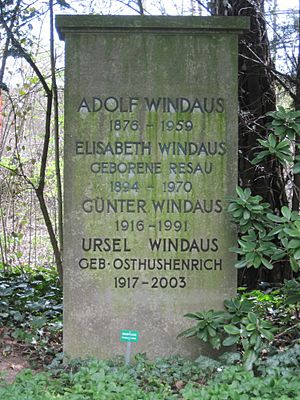Adolf Windaus facts for kids
Quick facts for kids
Adolf Windaus
|
|
|---|---|
 |
|
| Born |
Adolf Otto Reinhold Windaus
25 December 1876 |
| Died | 9 June 1959 (aged 82) |
| Nationality | German |
| Known for | Synthesis of vitamin D |
| Awards | Pour le Mérite for Sciences and Arts (1952) Goethe Medal (1941) Nobel Prize for Chemistry (1928) |
| Scientific career | |
| Fields | Organic chemistry biochemistry |
| Doctoral advisor | Heinrich Kiliani |
| Doctoral students | Adolf Butenandt Erhard Fernholz |
Adolf Otto Reinhold Windaus (born December 25, 1876 – died June 9, 1959) was a German chemist. He won the Nobel Prize in Chemistry in 1928. This award was for his important work on substances called sterols and how they relate to vitamins. He was also the teacher of Adolf Butenandt, who later won his own Nobel Prize in Chemistry in 1939.
Contents
About Adolf Windaus
Adolf Windaus was born in Berlin, Germany, on December 25, 1876. His family owned a fabric business. He went to a good French school where he mostly studied literature. Around 1895, Windaus started studying medicine at the University of Berlin. Later, he switched to studying chemistry at the University of Freiburg.
In 1915, he married Elizabeth Resau. They had three children named Günter, Gustav, and Margarete. After getting his PhD in medicine, Windaus became the head of the chemistry department at the University of Göttingen. He held this position from 1915 to 1944.
Throughout his life, Windaus received many awards. These included the Goethe Medal, the Pasteur Medal, and the Nobel Prize in Chemistry. Besides his scientific achievements, Windaus was also known for his bravery. He was one of the few German chemists who did not support the Nazis. He even openly spoke against their government. As the head of the chemistry department, he personally protected one of his Jewish students from being removed from the university. Windaus believed that science should be driven by curiosity, not by politics or war. Because of this, he refused to research poison gas during World War I.
Discoveries in Chemistry
Adolf Windaus made very important discoveries about sterols and vitamin D. Sterols are a type of organic molecule found in living things. The most famous sterol is cholesterol.
Understanding Sterols
Windaus began his research by studying sterols. He was especially interested in cholesterol. Cholesterol is found in all animals. Windaus wondered why cholesterol levels change in the body, like during pregnancy or illness.
He studied sterols in different animals, such as insects and sponges. He found that many of these animal sterols were similar to cholesterol. He also looked at sterols in plants, called phytosterols. Most plant sterols, like sitosterols, have a similar chemical formula to cholesterol.
Windaus also studied sterols found in fungi, called mycosterols. One important mycosterol he studied was ergosterol. Ergosterol is different from cholesterol because it has three double bonds instead of one. Interestingly, Windaus did not find any sterols in bacteria. His detailed research into the makeup of sterols and their link to vitamins earned him the Nobel Prize in Chemistry in 1928.
The Story of Vitamin D
In the early 1900s, a bone disease called rickets was common. This disease happens when someone doesn't get enough vitamin D. People tried to treat rickets with foods like milk or cod-liver oil. They also noticed that sunlight seemed to help.
Scientists first thought that cholesterol turned into vitamin D when exposed to UV light. But Windaus and his team found that very pure cholesterol did not work. This meant that a tiny impurity mixed with the cholesterol was actually the key. This impurity was a type of steroid with three double bonds.
Windaus and his colleagues discovered that ergosterol was the true precursor to vitamin D. When ergosterol was exposed to ultraviolet (UV) light, it changed into vitamin D2, also known as calciferol. This new vitamin D2 was incredibly effective at curing rickets. It was 100,000 times more powerful than fish liver oil!
Even after winning the Nobel Prize, Windaus kept researching. Ergosterol was found in fungi, but how did animals get vitamin D from sunlight? He later found another compound called 7-dehydrocholesterol in animal skin, milk, and liver. When this compound was exposed to UV light, it turned into cholecalciferol, or vitamin D3. This discovery helped explain how humans and animals make vitamin D naturally from sunlight.
Images for kids
See also
 In Spanish: Adolf Otto Reinhold Windaus para niños
In Spanish: Adolf Otto Reinhold Windaus para niños




